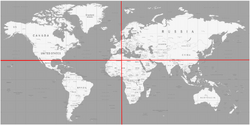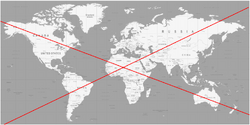Orthogonality
Introduction
In factorial analysis, "orthogonality" refers to variables that are independent and uncorrelated. When two factors are orthogonal, you can study their effects as if they are happening at a right angle to each other, rather than overlapping. This leads to a clearer understanding of each factor's contribution to the outcome. The opposite of orthogonal factors are oblique factors.
The idea of orthogonality in personality factors came from the studies on the Five Factor Model, and factors that may be extracted as orthogonal or oblique when analyzing a large number of personality nouns and adjectives in various languages.
Map Analogy
Consider the world map on the right. You may want to locate an individual on the map with the longitude and latitude. Those two dimensions are orthogonal.
You may want to locate the individual by two oblique factors as well, like with this other map on the right. The oblique factors may seem more practical for locating some people in some places of the map, rather than in others, which are out of focus for some analyses.
The first orthogonal system is simply more practical and generic than the second one to navigate, communicate about, remember, and use.
The same goes for behavioral dimensions that can be located by two, three, four factors or more. Orthogonal factors allow for the location and description of behaviors when the factors are as distant from each other as possible.
GRI Factors
GRI has four factors devised to be as distant from each other as possible. They cover the social behavior "map" in a way that can be more practical to analyze and use when locating, representing, modeling, and describing behaviors. Factor 1 contains as little as possible from factors 2, 3, and 4. The same goes for Factor 2, which contains as little as possible from factors 3 and 4. And the same between factors 3 and 4.
The main difference between the adaptive profiles and the map is that the four factors are represented on top of each other. That's because we are dealing with a four-dimensional space, and for practical reasons, we need to represent the four dimensions close to each other.



